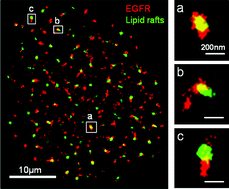Mechanistic insights into EGFR membrane clustering revealed by super-resolution imaging†
Abstract
The clustering of membrane receptors such as EGFR is critical for various biological processes, for example cell signaling and tumorigenesis. However, the mechanism involved remains poorly understood. Here, we used a super resolution imaging technique, which has shattered the longstanding resolution barrier of light diffraction, to investigate the distribution of membrane EGFR on apical or basal surfaces of COS-7 cells and on the surface of suspended COS-7 cells. Our data show that more and larger EGFR clusters are detected on the apical surface in comparison with those on the basal surface and this difference is not affected by the EGFR activation state, whereas suspended COS-7 cells exhibit a moderate clustering state and a homogeneous distribution pattern, indicating that the external environment surrounding the cell membrane is the decisive factor in the EGFR clustering pattern. A dual-color dSTORM image reveals the significant colocalization of EGFR and lipid rafts; interestingly MβCD treatment leads to a dramatic decrease of the amount and size of EGFR clusters on both apical and basal surfaces, highlighting a key role of lipid rafts in EGFR cluster formation. Altogether, our results illustrate the distribution pattern of EGFR in polarized cells and uncover the essential role of lipid rafts in EGFR cluster maintenance.


 Please wait while we load your content...
Please wait while we load your content...